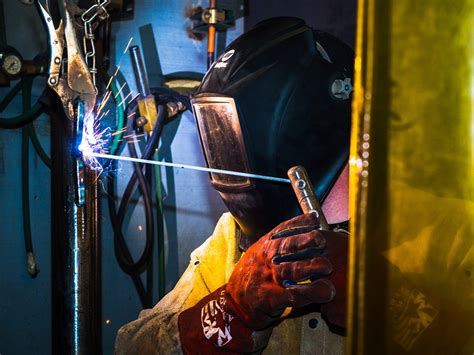Welding is a foundational skill that builds and maintains the modern world, from the tallest skyscrapers to the deepest offshore oil rigs. For those with a steady hand and a passion for skilled trades, it offers a durable and potentially lucrative career path. But how much can you actually expect to earn? While the national average provides a solid baseline, a welder's salary can skyrocket based on a combination of skill, location, and specialization, with top earners commanding six-figure incomes.
This article provides a data-driven look at the average salary of a welder, explores the key factors that influence your earning potential, and examines the future outlook for this essential profession.
What Does a Welder Do?

At its core, welding is the process of using high heat to join metal parts. A welder is a skilled professional who operates specialized equipment to fuse, cut, and shape metal components according to technical blueprints and specifications. Their work is critical in a vast range of industries, including:
- Construction: Creating the steel frameworks for buildings, bridges, and infrastructure.
- Manufacturing: Assembling automobiles, aircraft, ships, and machinery.
- Energy: Building and repairing pipelines, power plants, and offshore platforms.
- Maintenance and Repair: Fixing metal structures and equipment across virtually every sector.
The job requires immense precision, a deep understanding of metallurgy, and a steadfast commitment to safety protocols.
Average Welder Salary

To understand a welder's potential earnings, it's best to look at data from several authoritative sources.
According to the U.S. Bureau of Labor Statistics (BLS), the median annual wage for welders, cutters, solderers, and brazers was $50,440 in May 2023. This means that half of all welders earned more than this amount, and half earned less. The median hourly wage was $24.25.
However, this single number doesn't tell the whole story. The salary range is quite broad:
- The lowest 10% of welders earned less than $38,150.
- The highest 10% of welders earned more than $72,970.
Reputable salary aggregators provide a similar picture, often updated in real time. For example, Salary.com places the median welder salary slightly higher at around $54,345 as of early 2024, with a typical range falling between $48,343 and $61,993. This range often excludes highly specialized or senior roles, which can earn significantly more.
Key Factors That Influence Salary

The difference between earning a starting wage and a six-figure salary lies in several key factors. Understanding these variables is the first step for any aspiring or current welder looking to maximize their income.
### Level of Education and Certification
While a four-year college degree is not required to become a welder, formal training and certification are paramount. Most welders complete programs at vocational schools or community colleges. However, professional certifications are what truly unlock higher earning potential. The American Welding Society (AWS) offers numerous certifications, with the Certified Welder (CW) being a foundational credential. Earning a CW proves to employers that your skills have been tested and verified, often leading to an immediate pay increase and access to better job opportunities. Advanced certifications, like the Certified Welding Inspector (CWI), can move a professional from a hands-on role to a quality control position that often pays significantly more.
### Years of Experience
Like most professions, experience is a major driver of salary growth. Employers pay a premium for welders who have a proven track record of quality and efficiency.
- Entry-Level (0-2 years): A welder just starting out after completing a training program can expect to earn at the lower end of the spectrum, typically in the $40,000 to $48,000 range. This period is focused on honing skills and gaining real-world experience.
- Mid-Career (3-8 years): With several years of experience, welders can expect to earn at or above the national median, often in the $50,000 to $65,000 range. They are more proficient, require less supervision, and may begin to specialize.
- Senior/Expert (8+ years): Highly experienced welders, especially those with supervisory responsibilities or expertise in a high-demand specialty, can earn $70,000+. Those who become welding supervisors, inspectors, or project managers can see their salaries climb even higher.
### Geographic Location
Where you work matters immensely. Salary levels vary significantly by state and even by metropolitan area, often due to the cost of living and the concentration of specific industries. According to BLS data, the top-paying states for welders are:
1. Alaska: Average annual salary of $76,430
2. Wyoming: Average annual salary of $69,890
3. Hawaii: Average annual salary of $69,470
4. District of Columbia: Average annual salary of $68,890
5. North Dakota: Average annual salary of $66,970
States with heavy industrial, manufacturing, or energy sector activity (like oil and gas extraction in Alaska, Wyoming, and North Dakota) tend to offer higher wages to attract skilled labor.
### Company Type and Industry
The industry you work in is a powerful determinant of your pay. Welders are needed everywhere, but some sectors pay far more than others. The BLS identifies the following as top-paying industries for welders:
- Scheduled Air Transportation: $96,470 average salary
- Support Activities for Mining: $80,210 average salary
- Electric Power Generation, Transmission and Distribution: $78,510 average salary
- Natural Gas Distribution: $78,440 average salary
Working for a large manufacturing corporation or a specialty energy contractor will almost always pay more than a small, local repair shop.
### Area of Specialization
This is arguably the most significant factor for achieving a top-tier salary. General-purpose welders are always needed, but specialized welders with advanced skills are rare and highly compensated.
- Pipe Welding: Pipe welders, especially those who can work on high-pressure pipelines for the oil and gas or nuclear industries, are in constant demand and can earn $60,000 to over $100,000 annually.
- TIG (Tungsten Inert Gas) Welding: TIG welding is a precise process used on thin metals like aluminum and in high-stakes industries like aerospace and motorsports. Skilled TIG welders often earn a 15-25% premium over general welders.
- Underwater Welding: This is one of the most demanding and highest-paying specializations. It requires both commercial diving certification and expert welding skills to work on offshore oil rigs, ships, and subsea pipelines. Experienced underwater welders can earn anywhere from $100,000 to over $200,000 per year.
- Certified Welding Inspector (CWI): As mentioned earlier, transitioning into an inspector role leverages on-the-job experience for a higher-paying quality assurance position. CWIs can easily earn $70,000 to $100,000+.
Job Outlook

The career outlook for welders is stable. The BLS projects a 2% growth in employment for welders, cutters, solderers, and brazers from 2022 to 2032. While this is slower than the average for all occupations, it does not tell the full story.
The BLS notes that about 34,000 openings for welders are projected each year, on average, over the decade. Most of those openings are expected to result from the need to replace workers who transfer to different occupations or exit the labor force, such as to retire. Furthermore, the nation's aging infrastructure will continue to require skilled welders for repair and replacement projects on bridges, highways, and power generation facilities.
Conclusion

A career in welding offers a clear and attainable path to a solid, middle-class income and beyond. While the median salary hovers around $50,000 a year, this figure should be seen as a starting point, not a ceiling.
For those considering this career, the key takeaway is that your earning potential is directly in your hands. By investing in comprehensive training, pursuing industry-recognized certifications, gaining experience, and strategically choosing a high-demand specialization, you can build a career that is not only financially rewarding but also professionally respected and fundamentally essential to the economy.
